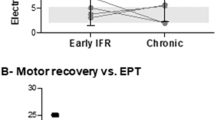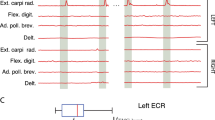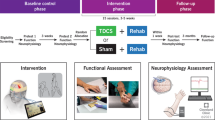Abstract
Study design:
Case report.
Objectives:
To identify preserved corticomotor connection in chronic spinal cord injury (SCI) in the absence of clinically observable movement.
Setting:
Rehabilitation Hospital and Medical Research Institute, NY, USA.
Methods:
The motor-evoked potential (MEP) response to transcranial magnetic stimulation (TMS) was recorded using surface electromyography from the right biceps brachii, extersor carpi radialis (ECR), flexor carpi radialis (FCR) and abductor pollicis brevis (APB) muscles in a 31-year-old male traumatic SCI chronic patient—ASIA B, injury level C5. Motor power scores were additionally obtained from a clinician blinded to the results of TMS.
Results:
TMS could consistently elicit MEPs of normal latency, phase and amplitude, in the severely affected ECR muscle but not the similarly affected FCR muscle. The response in proximal and unaffected biceps muscle was larger than the healthy subject, whereas no response was obtained in the distal APB muscle as expected.
Conclusion:
TMS can identify residual pathways not apparent from clinical assessment alone, which may have prescriptive value for rehabilitation.
Similar content being viewed by others
Log in or create a free account to read this content
Gain free access to this article, as well as selected content from this journal and more on nature.com
or
References
Kakulas BA . A review of the neuropathology of human spinal cord injury with emphasis on special features. J Spinal Cord Med 1999; 22: 119–124.
Calancie B, Alexeeva N, Broton JG, Suys S, Hall A, Klose KJ . Distribution and latency of muscle responses to transcranial magnetic stimulation of motor cortex after spinal cord injury in humans. J Neurotrauma 1999; 16: 49–67.
Cohen LG, Bandinelli S, Topka HR, Fuhr P, Roth BJ, Hallett M . Topographic maps of human motor cortex in normal and pathological conditions: mirror movements, amputations and spinal cord injuries. Electroencephalogr Clin Neurophysiol Suppl 1991; 43: 36–50.
McKay WB, Stokic DS, Dimitrijevic MR . Assessment of corticospinal function in spinal cord injury using transcranial motor cortex stimulation: a review. J Neurotrauma 1997; 14: 539–548.
Acknowledgements
The contents of the publication were developed under the NIH grants R01HD069776, R21HD060999 and K24 RR018875. We acknowledge Professor Frank Mastaglia for assistance in data interpretation and Dr Ana H Medeiros for assistance in the manuscript preparation.
Disclaimer
Dr Edwards developed the idea and was involved in each stage of experimental work and manuscript preparation. Dr Cortes and Ms Rykman contributed to data collection and manuscript preparation. Professor Pascual-Leone was involved in data interpretation and manuscript preparation. Professor Thickbroom was involved in the interpretation of the data and the drafting of the manuscript. Professor Volpe was involved with development of the idea, data interpretation and manuscript preparation.
Author information
Authors and Affiliations
Corresponding author
Ethics declarations
Competing interests
The authors declare no conflict of interest.
Rights and permissions
About this article
Cite this article
Edwards, D., Cortes, M., Thickbroom, G. et al. Preserved corticospinal conduction without voluntary movement after spinal cord injury. Spinal Cord 51, 765–767 (2013). https://doi.org/10.1038/sc.2013.74
Received:
Revised:
Accepted:
Published:
Issue date:
DOI: https://doi.org/10.1038/sc.2013.74
Keywords
This article is cited by
-
Quantitative electrophysiological assessments as predictive markers of lower limb motor recovery after spinal cord injury: a pilot study with an adaptive trial design
Spinal Cord Series and Cases (2022)
-
Targeted-Plasticity in the Corticospinal Tract After Human Spinal Cord Injury
Neurotherapeutics (2018)
-
The corticomotor projection to liminally-contractable forearm muscles in chronic spinal cord injury: a transcranial magnetic stimulation study
Spinal Cord (2017)
-
Response to ‘Preserved corticospinal conduction without voluntary movement after spinal cord injury’
Spinal Cord (2014)
-
Reply: Evidence against volume conduction to explain normal MEPs in muscles with low motor power in SCI
Spinal Cord (2014)



